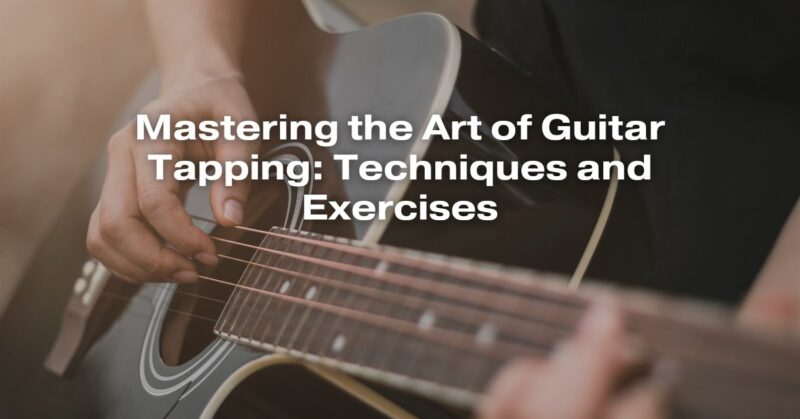The technique of guitar tapping, made famous by guitar virtuosos like Eddie Van Halen and Steve Vai, has captivated musicians and guitar enthusiasts for decades. It’s a technique that adds a unique and dazzling element to a guitarist’s repertoire, allowing for lightning-fast, melodic, and rhythmic runs that push the boundaries of what the guitar can do. In this article, we’ll explore the art of guitar tapping, delve into various tapping techniques, and provide a set of exercises to help you master this impressive skill.
What is Guitar Tapping?
Guitar tapping involves using one or both hands to tap the strings against the fretboard to produce notes. Typically, this is done on the neck of the guitar, usually on the higher-pitched strings, like the B and high E strings. While it’s most often associated with electric guitars, tapping can also be done on acoustic guitars and other stringed instruments.
Tapping creates a staccato, bell-like sound that’s distinct from the usual plucking or picking of guitar strings. It allows for exceptionally fast and fluid note sequences, which can be used for solos, fills, or unique rhythm parts.
Basic Tapping Technique
Before diving into more advanced tapping techniques, it’s essential to grasp the basic tapping technique. Here’s a step-by-step guide:
- Choose Your Fret Hand: Decide which hand you want to use for tapping. Most guitarists use their dominant hand (right for right-handed players and left for left-handed players) for tapping, while the other hand handles fretting.
- Position Your Hands: Start by placing your fretting hand on the guitar neck in a comfortable position, typically around the 5th to 12th frets. Your tapping hand should hover above the neck, with your thumb resting lightly on the back for stability.
- Select the String: Choose the string you want to tap. Beginners often start with the high E string (the thinnest string) because it requires less force to tap.
- Tap the Note: Use your tapping finger (usually the index or middle finger) to tap the string against the fret. The motion should be a quick, controlled tap. The harder you tap, the louder the note will sound.
- Release: After tapping, release your tapping finger immediately to let the string ring out. Keep your other fingers on your fret hand in position to sustain the note if necessary.
- Experiment with Hammer-Ons and Pull-Offs: To create fluid melodic sequences, you can combine tapping with hammer-ons (tapping a note, then hammering another finger onto the same string) and pull-offs (tapping a note, then pulling off to a lower fret).
Advanced Tapping Techniques
Once you’ve mastered the basic tapping technique, you can explore more advanced techniques to add depth and complexity to your playing:
1. Two-Handed Tapping
This technique involves using both hands for tapping, creating a more complex and harmonically rich sound. You can tap with both hands simultaneously or alternate between them for intricate patterns.
2. Tapping Arpeggios
Tapping can be used to play arpeggios, which are broken chords played one note at a time. Experiment with various arpeggio shapes and patterns to create beautiful and melodic runs.
3. Tapping Chords
You can tap full chords or chord fragments to create lush, harmonically dense sounds. This technique is commonly used in progressive rock and metal music.
4. Tapping with Tapping Slides
Tapping slides involve sliding your tapping finger up or down the fretboard after tapping a note. This adds a unique and smooth glissando effect to your playing.
5. Tapping with Tapped Harmonics
Combine tapping with natural or artificial harmonics to create ethereal and otherworldly sounds. This technique requires precise control and can yield impressive results.
Tapping Exercises for Mastery
To become proficient at guitar tapping, consistent practice is crucial. Here are some exercises to help you develop your tapping skills:
1. Basic Tapping Drill
- Start with a metronome set to a comfortable tempo.
- Tap on the 12th fret of the high E string, using your index finger.
- Begin with quarter notes, then move to eighth notes, triplets, and sixteenth notes.
- Gradually increase the tempo as you become more comfortable.
2. Two-Handed Tapping Exercise
- Pick a simple melody or scale pattern.
- Use your fret hand to play the melody notes while tapping harmonies with your tapping hand.
- Experiment with different harmonies and rhythms.
3. Tapping Arpeggios
- Choose a specific arpeggio shape (e.g., a major 7th arpeggio).
- Tap the notes of the arpeggio on the high E string.
- Practice ascending and descending the arpeggio with precision and fluidity.
4. Tapping Chord Progression
- Create a chord progression and tap the chords.
- Experiment with different chord shapes and inversions.
- Focus on smooth transitions between chords.
5. Tapping Harmonics Exercise
- Practice tapping natural harmonics at the 12th, 7th, and 5th frets.
- Experiment with tapping artificial harmonics by lightly touching the string at specific points and tapping 12 frets above.
Conclusion
Mastering the art of guitar tapping can open up a world of creative possibilities for guitarists. Whether you’re interested in shredding impressive solos or adding unique textures to your compositions, tapping is a technique worth exploring. Start with the basics, experiment with advanced techniques, and incorporate tapping exercises into your regular practice routine. With dedication and persistence, you can become a proficient tapper and use this technique to elevate your guitar playing to new heights. Happy tapping!


